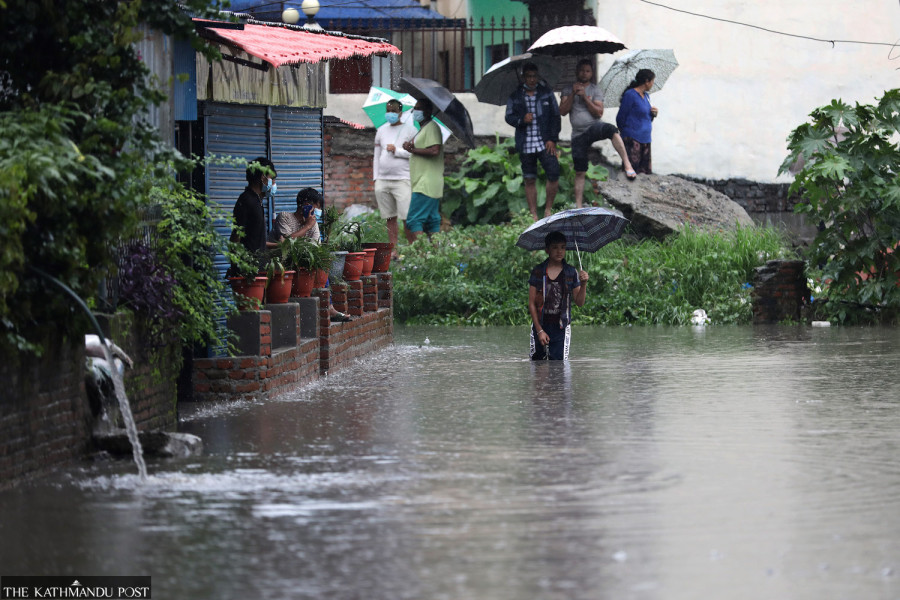Climate & Environment
Country continues to receive above-normal rain three months into monsoon
The amount of rain received between June 1 and August 6 is 69.9 percent of the rainfall the country gets in the whole monsoon season, meteorologists say.
Chandan Kumar Mandal
The ongoing monsoon has continued to receive excess rainfall than its seasonal average.
The four-month period, which is in its third month, has received nearly 70 percent of its rainfall for the season as of now.
Rainfall data with the Department of Hydrology and Meteorology for the 20 major rainfall monitoring stations across the country show that Nepal has received 981.2mm rain as of Friday.
The amount of rain the country has received between June 1 and August 6 is 69.9 percent of the rainfall the country gets in the whole monsoon season.
According to Indira Kadel, a senior meteorologist with the department, most of these stations have received above normal rainfall for their seasonal average.
“The rainfall data include precipitation recorded by those stations since June 1, which is the beginning of the monsoon season. However, monsoon onset can differ every year,” said Kadel, who also heads the Climate Analysis Section of the department. “The rainfall amount clearly shows that we have received more rain in the last two months of the season.”
Among the 20 major stations of which data for the last two months have been publishemountd, all stations except Nepalgunj have crossed their normal rainfall mark, according to the department.
The country has received excess rainfall since the pre-monsoon period this year. Nepal had witnessed an above-average pre-monsoon (March to May) when a significant amount of rain had occurred in its last lap. As per the department’s data, average precipitation of 291.7 mm was recorded during the pre-monsoon of 2021, which was 29 percent higher than the seasonal average.
The above-average rainfall trend has continued in the monsoon period as well.
Monsoon entered the country on June 11 this year. Days after the monsoon clouds arrived, torrential rain started wreaking havoc across the country, unleashing floods and landslides.
The first month of the season showed that most parts of the country received rainfall above the average for the month of July, which triggered massive flooding and landslides in the country.
According to precipitation data from 71 stations across the country, the month of June received 399mm of rain, some 35.2 percent above average. The normal rainfall recorded at those 71 stations in June is 295.1mm.
The department, however, does not have complete rainfall data for the month of July because of technical issues on its server.
“What we have seen this time is June came with lots of rain and the last week of July went dry,” said Kadel. “But when we talk about the overall rainfall in the first two months of monsoon season, then it has crossed its average rainfall mark.”
As per the rainfall data accumulated between 1981 and 2010, Nepal on average receives 1462.4mm rainfall in the four months from June to September. The month-wise breakdown shows June contributes 19.3 percent, followed by July 33.4 percent, August 29.1 percent and September accounts for 18.2 percent.
“Generally, June and July receive around 50 percent of the monsoon rain. This year, nearly 70 percent rainfall was recorded in the two months,” said Kadel.
The impact of excess rainfall was witnessed across the country that has seen numerous monsoon-induced disasters like floods and landslides, including prominent ones in Sindhupalchok, Manang and Lamjung districts.
The three districts, especially the Melamchi area of Sindhupalchok, have been battered by seasonal floods, leaving hundreds of families displaced.
According to the First Monthly Report on Monsoon 2021 of the National Disaster Risk Reduction and Management Authority released two weeks ago, 61 people lost their lives to monsoon-induced disasters between June 11 and July 15.
The report highlighted that as many as 47 districts were affected by disasters like landslides, floods, thunderstorms and heavy rainfall this year. In the very first month of the monsoon, as many as 332 such incidents—143 landslides, 126 incidents of heavy rainfall and 63 floods—were reported across the country, leaving scores dead and hundreds others displaced.
Another set of data on disasters and loss and damages of the authority showed as many as 153 people were reported dead in a total of 1,354 disaster incidents between April 14 and August 6, which also includes two monsoon months.
The country is predicted to have above-normal rainfall this year, raining concerns over similar weather extremes in the coming weeks.
“We have to see how much rain we get in the remaining monsoon period. July and August are the peak months of monsoon whereas June and September usually receive less rainfall. Since August has nearly three weeks remaining, more rain is likely,” said Kadel.




 22.64°C Kathmandu
22.64°C Kathmandu














